Exploring Foiling Boards in Kiteboarding: A Comprehensive Guide
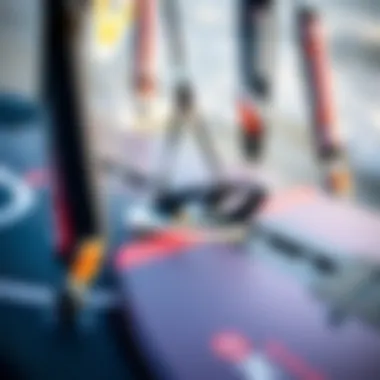
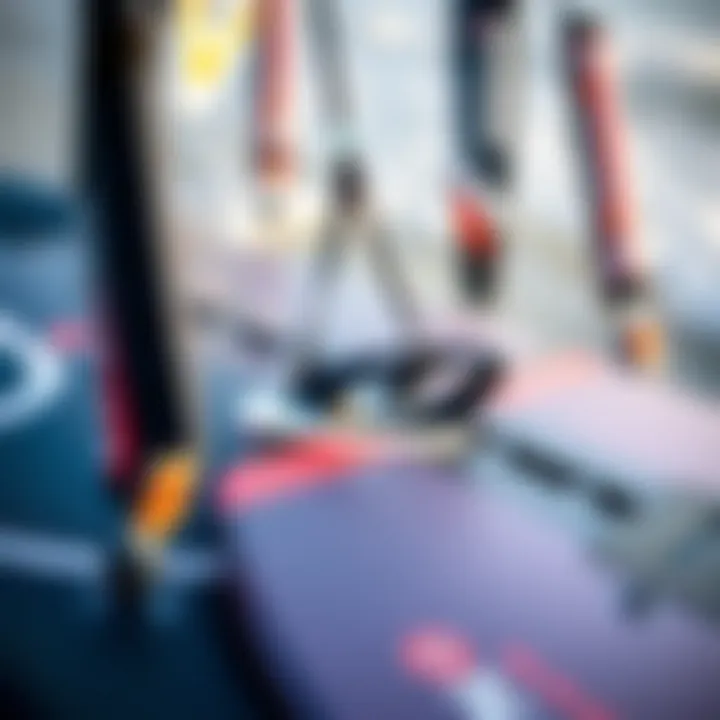
Intro
In the world of kiteboarding, foiling boards are carving out a niche that’s hard to ignore. This innovation in design not only enhances the surfing experience but also brings a unique set of dynamics to the sport. Foiling essentially involves riding a board that is lifted above the water’s surface by a hydrofoil, allowing for smoother navigation, reduced drag, and increased speed. For both novices and seasoned adventurers, understanding the ins and outs of foiling boards is crucial to maximizing performance and enjoyment.
Kiteboarding itself is a dance with the wind, combining elements of surfing, windsurfing, and paragliding. Foiling adds another layer, as it shifts the way riders interact with the water, offering an almost surreal floating sensation. Unlike traditional boards, foiling boards allow the rider to glide without the board constantly in contact with the ocean surface.
This article will unfold the layers that make foiling boards both complex and enticing. We will cover essential gear and equipment, dive into techniques and training tips, and – of course – explore safety practices that every kiteboarder should keep in mind. By understanding both the technical aspects and practical tips, riders can elevate their kiteboarding experience to new heights.
Let’s dive right in, beginning with the fundamental gear and equipment.
Gear and Equipment
Understanding the right gear is imperative, whether you're just getting your feet wet or pushing the limits of your performance.
The choice of equipment can dramatically shape your learning curve and your experience on the water.
Essential Kiteboarding Gear for Beginners
- Kite: Start with a stable, easy-to-handle kite, like the Ocean Rodeo Rise or the F-One Bandit. These are favorable due to their user-friendly nature and consistent performance.
- Board: A beginner-friendly twin-tip board is advisable, allowing for easier transitions and stability. The Slingshot Misfit is a popular choice.
- Control Bar and Lines: Invest in a reliable control bar, where options like the Naish Torque are notable for their responsiveness and safety features.
- Harness: Your connection point to the kite. A comfortable and supportive harness like the Mystic Warrior will give you the confidence to ride longer and more comfortably.
- Safety Gear: Don’t skimp on a helmet and impact vest. They’re not just for show; they offer essential protection when learning.
Advanced Equipment for Experienced Riders
Once you've found your footing and are flying high, it’s time to upgrade your gear for optimized performance.
- High-Performance Kite: Look for models like the Core GTS6, which offers enhanced maneuverability and responsiveness for advanced tricks.
- Foiling Board: A dedicated foiling board, such as the Fanatic Gecko, will add to your experience, allowing for sharper turns and heightened speed.
- Hydrofoil Kit: Advanced riders might choose a modular hydrofoil kit. Brands like Lift foil offer customizable experiences that can be tailored your specific riding style.
As you grow, experiment with different setups to find what works best for you. Remember, every rider is unique, and what suits one might not suit another.
"Gear does not make the kiteboarder, but the right tools can certainly elevate the experience and improve performance."
In the next section, we’ll explore the techniques and tips that will further refine your skills and enhance your safety on the water.
Foreword to Foiling Boards
The emergence of foiling boards has fundamentally shifted the paradigm of kiteboarding. When the wind grabs the kite, that lift off the water isn't just thrilling; it's an invitation to explore a new dimension of the sport. Foiling boards enhance the experience in ways that traditional boards cannot, allowing riders to skim over the water with minimal drag. This not only amplifies speed but also opens up opportunities for various maneuverability that keeps both amateurs and seasoned pros on their toes.
Foiling isn’t merely a trend; it represents an evolution within kiteboarding, bringing unique characteristics that can be both exhilarating and challenging. As the dynamics of foiling boards continue to develop, their significance lays in their technical complexity and the unmatched thrill they offer in navigating wind and water.
The Evolution of Kiteboarding
Kiteboarding, originally born out of a fusion of surfing, paragliding, and windsurfing, has witnessed a dramatic evolution since its inception. It began as a basic sport where riders used kites to pull themselves across the water on a surfboard. Early enthusiasts were often faced with limitations in speed and agility. However, they harnessed creativity, experimenting with various kite designs and board shapes to enhance their riding experience.
The introduction of foiling technology marked a watershed moment in the sport. As riders began experimenting with hydrofoils, the ability to ride above the water's surface became more than just a novelty. This technological leap changed the game. Before long, the kiteboarding community had fully embraced foiling boards, effectively changing how riders engage with the elements. New skills emerged, including the intricate balance of lift and drag, and riders found themselves pushing the boundaries of what was previously thought possible.
Understanding Foiling in Water Sports
Foiling in water sports, particularly kiteboarding, operates on a simple yet transformative principle: the hydrofoil gliding beneath the board. This setup allows riders to elevate above the water, minimizing surface resistance and maximizing speed. The sense of riding on a cushion of air rather than water is an exhilarating experience, akin to floating, and opens up myriad possibilities for tricks and maneuvers.
The dynamics of foiling offer a different kind of challenge. Riders must adapt to unique forces at play. For instance, dialing in the right balance between kite power and foil responsiveness is crucial. Mismanagement can result in a tumble that feels like falling from the clouds, albeit not quite as serene!
Fundamentals of Foiling Boards
Understanding the fundamentals of foiling boards sets the stage for kiteboarding enthusiasts to harness the thrilling potential of this innovative sport. Foiling boards elevate the riding experience by allowing riders to glide above water with reduced drag, offering a unique combination of speed and agility. The mechanics behind these boards not only enhance performance but also open doors to new possibilities in riding styles and techniques.
What is a Foiling Board?
A foiling board is a specially designed aquatic board that incorporates a hydrofoil, which is essentially an underwater wing that lifts the board above the water's surface as it gains speed. This design minimizes water resistance, providing a smoother and faster ride. Riders find themselves floating, enjoying an exhilarating sensation often described as flying.
The appeal of foiling boards is broad, as they cater to various skill levels and offer an exhilarating way to ride waves or flat water. The concept may seem complex, but understanding its basic principle is quite straightforward: more speed equals more lift.
Components of a Foiling Board
To grasp the fundamentals, one must consider the key components that define a foiling board.
Board Design
The board's design is a crucial aspect influencing ride quality. Generally, foiling boards come in various shapes and sizes tailored for different styles of riding. A significant characteristic of board design is concavity, which can enhance performance by allowing quicker turns and better control. Riders often choose boards with a slight rocker to further help with maneuverability.
An intriguing feature in many modern foiling boards is the use of lightweight materials like carbon fiber, which balances strength with minimal weight—a beneficial choice for achieving optimal performance without compromising stability.
Foil Structure
The foil structure consists of a mast, wings, and fuselage; each plays a vital role in how a board performs. Notably, wing design significantly affects lift, drag, and stability. Wider wings may enhance lift at slower speeds, which is advantageous for beginners or those aiming to ride in light winds, while smaller wings are typically preferred by advanced riders seeking high-speed performance.
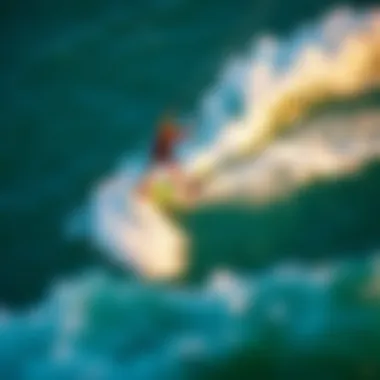
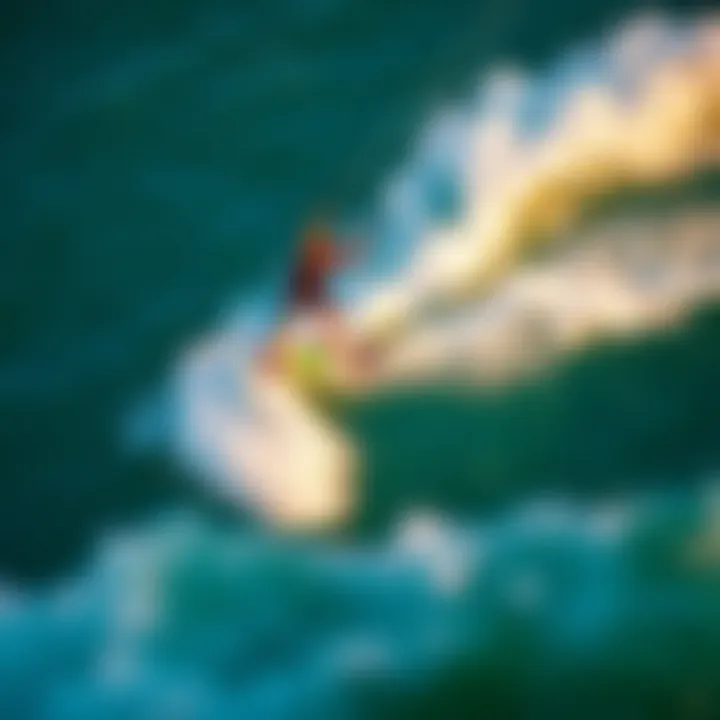
Additionally, the aspect ratio of the wings can influence efficiency. High aspect ratio wings offer better glide and speed, which can easily be beneficial for performance racing or kite racing. However, they may also introduce difficulty in balance for less experienced riders.
Fins and their Importance
Fins are often overlooked but play a substantial part in a foiling board's dynamics. They serve to maintain directional stability when a rider is not foiling, helping to keep the board straight when starting or riding at low speed. The fin placement impacts the board's handling characteristics significantly. Riders may choose to customize fin shapes or sizes to suit their riding style, providing options for faster acceleration or better grip during turns.
Types of Foiling Boards
Understanding the various types of foiling boards is crucial for anyone eager to navigate the waters of kiteboarding. Each type caters to different styles, preferences, and conditions, playing a significant role in enhancing performance. Knowing the distinctions between them can be a game-changer for riders looking to level up their game.
All-around Foiling Boards
All-around foiling boards are the Swiss army knife of the kiteboarding world. They offer versatility that appeals to both beginners and seasoned riders alike. These boards typically have a balanced volume and width that makes them suitable for various riding conditions and styles.
The design usually incorporates a medium size foil, allowing for stability and ease of use, thereby accommodating riders who want to practice jumping, carving and cruising without being overly specialized.
Benefits of All-around Foiling Boards include:
- Stability: They provide a dependable platform for learning and practicing.
- Flexibility: Riders can experiment with different techniques without being restricted.
- Transition-friendly: Easier to switch between various riding styles, from freestyle to free ride.
Race Foiling Boards
Race foiling boards are top-notch choices for those who thrive on the adrenaline of competition. Engineered for speed, these boards excel in flat water conditions, allowing experienced riders to maximize their performance in races. Their slim shapes and minimal drag are designed to cut through water with incredible efficiency, often at the expense of some stability.
These boards typically feature:
- Narrower profile: Designed for cutting through wind with ease.
- Lighter materials: Construction often incorporates advanced composites to reduce weight.
- Enhanced foil compatibility: Optimized to work with a variety of performance-focused foil designs.
While race boards are great for speed, they may not be the best option for beginner kiteboarders due to their particular focus on performance and reduced stability compared to all-around boards.
Freestyle Foiling Boards
Freestyle foiling boards pack in a level of freedom that appeals to riders wanting to express themselves through tricks and aerial maneuvers. These boards usually come with a wider stance and additional volume, offering the buoyancy necessary for jumps and flips. In many cases, they are shorter, making it easier for riders to pivot and land tricks smoothly.
Here are a few aspects of Freestyle Foiling Boards:
- Easy maneuverability: Designed for quick turns and flips.
- Increased buoyancy: Helps in holding the water surface longer during jumps.
- Durable construction: Built to withstand the rigors of intense trick riding.
These boards can be an absolute delight for skilled riders but may present challenges for those who are still honing their fundamental skills.
Surf Foiling Boards
Surf foiling boards are tailored for those who want to ride the waves rather than just carve through flat waters. These boards usually exhibit a longer and thicker design to accommodate the dynamics of ocean swells. The main goal is to ride efficiently over waves, allowing riders to harness the strength of natural water movement.
Characteristics of Surf Foiling Boards include:
- Easy paddling: Designed for surfing, thus able to paddle easily into waves.
- Flexibility on turns: A larger surface area allows for aggressive turns and riding higher up on the wave.
- Durability in saltwater: Usually constructed to withstand the corrosive elements of ocean water.
Each type of board offers particular advantages and limitations that correspond to the rider's experience and style. Ultimately, selecting the right foiling board can enhance not just performance but also the overall experience on the water, making every ride memorable.
Performance Insights
Understanding performance insights is essential for any kiteboarder looking to maximize the potential of foiling boards. In this segment, we will look into various factors that impact your ride, explore optimal conditions for foiling, and provide an overall picture of what can make or break a session on the water.
Factors Affecting Performance
Board Size
Board size plays a pivotal role in how a rider interacts with the water. A larger board generally offers more stability, making it a favorable choice for beginners who are still finding their sea legs. The extra surface area allows for a more forgiving ride.
On the flip side, larger boards can be sluggish in terms of speed and maneuverability. If you’re chasing performance and plan on executing sharp turns, a smaller board might be the way to go. It’s a bit like choosing between a lumbering truck and a sporty coupe on the road—each has its own advantages depending on what you’re aiming to achieve.
Weight Distribution
The distribution of weight on the board significantly influences performance. Riders typically find that shifting their weight toward the back of the board allows for better lift off the water, particularly during light wind conditions. This technique can make a massive difference, transforming an average day into something extraordinary.
However, concentrating too much weight on the tail may result in a lack of control. Finding that sweet spot can take some trial and error, but it’s crucial—much like tuning an instrument to get that perfect sound. Careful balance is key to a harmonious ride.
Foil Design
Foil design is where the magic truly happens in foiling performance. The shape and construction of the foil dictate how well it glides through the water and interacts with the wind. A well-designed foil contributes to smoother transitions and improved lift, enabling kiteboarders to fly above the waves rather than cutting through them.
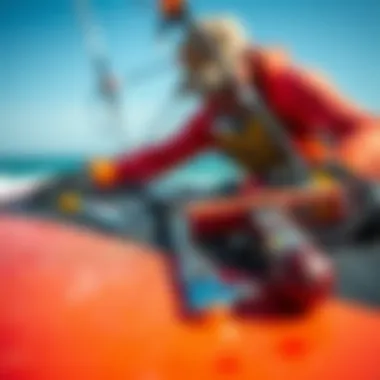
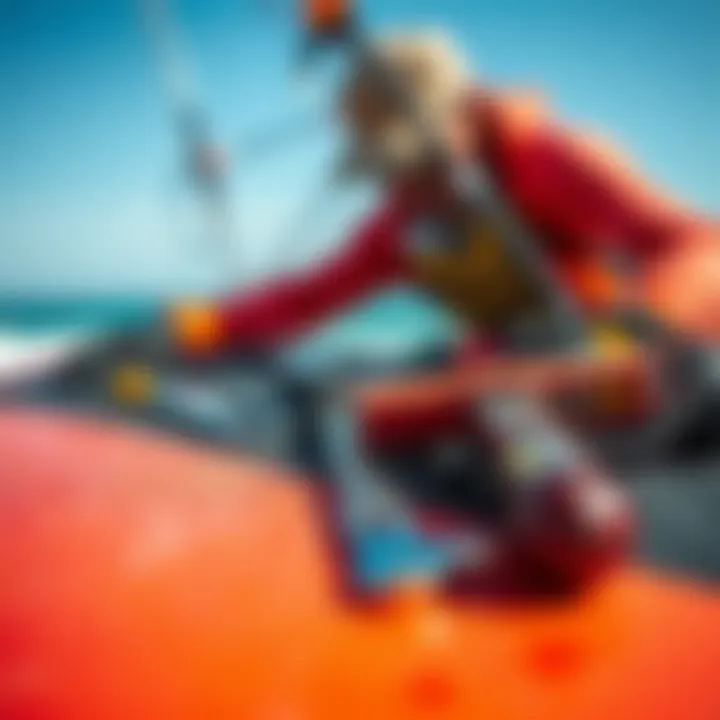
But not all foils are created equal. For instance, stiffer foils may offer more speed, while flexible foils can provide better comfort in choppy waters. Understanding the kind of experience you’re after—whether it’s speed or a serene ride—will help narrow down your selection.
Optimal Conditions for Foiling
To truly enjoy foiling, knowing the optimal conditions is essential. Each factor contributes to a rider's experience and can dramatically affect performance.
Wind Requirements
Good winds are the lifeblood of any kiteboarder. For foiling boards, wind speed of around 12-20 knots is often ideal. This range helps ensure that you have enough lift while maintaining control. Riding in too light of winds can make it difficult to achieve that magical hydrodynamic lift.
However, strong winds can be a double-edged sword. They can lead to unpredictable conditions, which might overwhelm less experienced riders. It’s advisable to always check weather forecasts and go out when conditions are favorable.
Water Conditions
Water conditions are just as critical and should not be overlooked. Flat water provides the best scenario for new foilers, allowing them to build confidence. Conversely, choppy waters can be more challenging and may demand a higher skill set to navigate successfully.
Some seasoned riders even enjoy the thrill of surf conditions, finding the dynamic nature exhilarating. Knowing your territory, or finding the right spot to ride, can greatly impact your overall experience.
User Skill Level
Lastly, we can’t forget about user skill level. Beginners may do best sticking to the basics with manageable conditions until they build their skills. As you advance, you may wish to tackle different setups that require sharper skills.
Different setups cater to different skills. Advanced riders often prefer boards that allow for variety in technique—this can make once tricky maneuvers a walk in the park. Each level of skill brings its own set of expectations for what gear will be successful or enjoyable, shaping the overall experience.
Ultimately, knowledge about performance insights lays the groundwork for a richer, more engaging kiteboarding experience. Understanding how board size, weight distribution, foil design, wind conditions, water types, and user skills interplay can help kiteboarders make informed choices that elevate their time on the water.
Setting Up Your Foiling Board
Setting up your foiling board is a critical step that greatly influences your performance and enjoyment while kiteboarding. It’s not just about slapping things together; rather, it requires a thoughtful approach to balance, stability, and user experience. This part of the kiteboarding process unearths the potential of both the board and rider, ensuring that you're primed to conquer the water.
Choosing the Right Foil
Choosing the right foil is akin to picking the perfect partner for a dance. You want something that complements your style and helps you glide effortlessly through the waves. The first factor to consider is size; a larger foil, often touted for its lift, might be suitable for lighter winds or less experienced riders, while a smaller foil requires a surer hand and is ideal for higher speeds and skilled maneuvers.
Next is the shape. A surf-style foil typically has a more rounded wing, granting better turning capability and is great for wave riding. On the other hand, a flat wing design can provide speed and stability, making it a suitable choice for racing scenarios.
In summary, factors to consider include:
- Size: larger foils for stability, smaller for agility
- Shape: rounded wings for turns, flat wings for speed
- Material: composite foils tend to be more durable, while aluminum is typically lighter
Adjusting the Foil Position
Once you've got your foil, the next step is to adjust its position on the board; this is where the magic happens. The positioning of the foil will directly affect how the board behaves in the water. Imagine the foil is a pendulum; if it’s too far forward, you might find your nose diving into the waves, but if it's too far back, you may struggle to achieve the lift that allows you to soar above the water.
Generally, it's advisable to start with the foil positioned slightly towards the back and adjust based on how it feels during your trials. A common technique involves adjusting a few centimeters each time until you find that sweet spot. Keep in mind, every rider has a unique preference based on weight and riding style.
- Forward Position: can boost early lift but may lead to a nose dive.
- Backward Position: can provide better control but may delay lift.
Safety Gear Recommendations
Safety should never take a backseat, as the thrill of kiteboarding comes with its own set of risks. Proper safety gear is non-negotiable and can mitigate accidents that might occur while riding. It’s wise to outfit yourself with appropriate gear that safeguards against unexpected splashes, crashes, or falls.
Mandatory gear includes:
- Helmet: Protects your head from impact in case of a fall or collision.
- Impact Vest: Cushions your body and reduces the risk of injury from hard landings.
- Foot Protection: Whether it’s boots or specific footwear, protecting your feet from the board and water conditions is key.
Moreover, investing in a safety leash is recommended. This straightforward device ensures your board doesn’t drift away should you fall off, helping keep both you and your equipment secure.
Remember, kiteboarding is as much about enjoying the ride as it is about navigating it safely.
"Proper setup leads to a smooth ride; neglect it, and you may find yourself tangled in more than just the lines."
By focusing on these pivotal elements, you can enhance your kiteboarding experience significantly. Every rider’s requirements may differ, and tailoring your setup to suit your personal style will ensure you’re not just riding—you’re flying.
Maintenance of Foiling Boards
Maintaining foiling boards is not just about keeping things looking shiny. It's a crucial aspect of ensuring safety, performance, and longevity of the board. Neglecting maintenance can lead to subpar performance and even dangerous situations out on the water. This section dives into essential practices that every kiteboarder should embrace to keep their gear in top shape.
Cleaning Techniques
Proper cleaning is vital to uphold the integrity of your foiling board. Over time, saltwater, sand, and dirt can wreak havoc on the materials. Here are a few techniques:
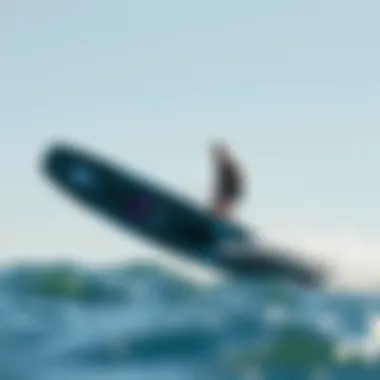
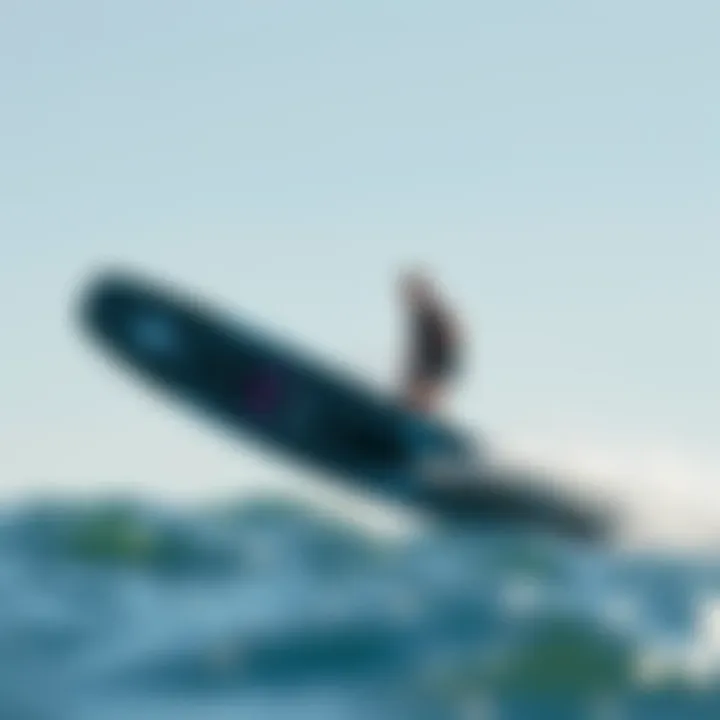
- Rinse with Fresh Water: After each session, a good rinse with freshwater helps eliminate salt residue, which can cause corrosion over time.
- Gentle Scrubbing: For stubborn grime, use a soft sponge or cloth. Avoid abrasive materials that can scratch the surface.
- Mild Detergent: When necessary, a mix of water and mild detergent can be helpful. Just ensure to rinse thoroughly afterward to prevent any soapy residue.
- Drying: Hang the board upright in a shaded area after rinsing. Direct sunlight can warp materials, so keeping it shaded is preferable.
"A clean board performs better and lasts longer; neglect brings danger and disappointment."
Being diligent with these cleaning techniques not only helps in maintaining the board's aesthetics but also preserves its structural integrity.
Storage Best Practices
How you store your foiling board can significantly influence its lifespan. Here are some best practices:
- Keep it Indoors: Whenever possible, store the board indoors to protect it from sun damage and extreme weather.
- Avoid Weight on Top: When stacking boards, avoid placing heavy items on top. This can lead to deformities that affect performance.
- Use a Board Bag: Utilizing a padded board bag provides protection from impacts and scratches during transport and storage.
- Position it Horizontally: Align the board flat rather than standing up. This helps maintain its shape and prevents unnecessary pressure on the fins.
- Temperature Control: Storing in a climate-controlled environment is a bonus. Avoid places with significant temperature fluctuations that might affect the materials.
Maintaining and storing foiling boards properly goes a long way toward ensuring a safe and enjoyable ride on the water, protecting your investment both from wear and tear as well as ensuring that you get the most out of your sessions. It's well worth the effort to learn and implement these best practices.
Safety Considerations in Foiling
Safety considerations are paramount in foiling, especially as the sport continues to grow in popularity. With kiteboarding using foiling boards, riders experience a unique thrill, but it also brings along inherent risks. Understanding and prioritizing safety not only keeps you out of harm’s way but also ensures a more enjoyable experience. Here’s what you need to know about safety in foiling.
Identifying Risks
Foiling boards come with unique risks that every rider should recognize before hitting the water. Here are some key risks to keep in mind:
- Equipment Failure: Just like any other sport, maintaining your gear is crucial. A malfunctioning foil can lead to unexpected accidents. One might imagine being airborne one moment, then suddenly dealing with a sudden fall due to a broken fin. Regular inspections can help avoid this.
- Inexperience: A rider with insufficient experience can pose risks, not only to themselves but also to others nearby. Novices may struggle to manage their speed or control the board, which can lead to collisions. Going for lessons or practicing in areas with fewer people can significantly reduce risks.
- Environmental Hazards: Know your surroundings. Hidden rocks, shallow waters, or busy beaches can all pose dangers. A moment's distraction can lead to grave injuries. Visualizing the area and scouting for potential hazards before diving into the water is wise.
- Weather Conditions: Kiteboarding in poor weather conditions can be disastrous. Strong winds can easily overpower even seasoned riders, putting them at risk of losing control. Always check wind and water conditions before starting your session.
"A water sport is only enjoyable when safety takes precedence. Ignoring risks is like sailing without a compass; you may end up lost."
Safety Protocols to Follow
To mitigate these risks, following specific safety protocols is essential:
- Pre-Flight Checks: Before approaching the water, conduct a thorough check of your gear. Inspect the foil, board, and kite for any visible issues. Ensure all components are secured and functioning correctly. This will instill confidence as you ride.
- Personal Flotation Devices (PFDs): Wear a suitable PFD. While it may feel cumbersome, it can save lives. It’s like having an insurance policy against unforeseen mishaps. Choose a comfortable design that allows for freedom of movement while still providing the necessary support.
- Kiteboarding Zones: Stay informed about designated kiteboarding areas. Riding in these zones minimizes the risk of collisions with swimmers or other watercraft. Respecting the space also enhances the overall experience for everyone involved.
- Buddy System: Whenever possible, kiteboard with a partner. Having someone on hand can assist during emergencies. Whether it’s giving you a signal when your kite tangles or helping you back up after a spill, a buddy can make a difference.
- Enforce a Safety Briefing: When kiteboarding as a group, conduct a briefing to discuss safety protocols, signals, and possible hazards in the vicinity. Clear communication can avert misunderstandings and enhance awareness among the group.
- Continuous Learning: Take ongoing safety courses and workshops. Kiteboarding technology is ever-evolving, and keeping abreast of the latest safety information can profoundly influence your practices.
In summary, navigating the thrilling world of foiling in kiteboarding requires more than just skill and passion; it requires dedication to safety as a top priority. By following the outlined protocols and being aware of inherent risks, kiteboarders can ensure a memorable and safe experience on the water.
Future Trends in Foiling Boards
Foiling boards are evolving rapidly, and staying updated with these trends is essential for anyone involved in the sport, from beginners to seasoned veterans. The importance of understanding these trends lies in ensuring that kiteboarders can maximize their performance and safety while enjoying their time on the water. As technology advances, so do the materials and designs used in manufacturing foiling boards.
Innovations in Material Science
Recent innovations in material science have opened the door to more efficient, lightweight, and robust foiling boards. Here are a few significant advancements that are shaping the future:
- Carbon Fiber Composites: This material is becoming increasingly popular due to its high strength-to-weight ratio. Boards made with carbon fiber tend to perform better because they are stiffer and lighter, translating to better speed and maneuverability on the water.
- Foam Core Technology: Engineers are also exploring new foam core materials that combine buoyancy and strength. Lightweight foams can now be paired with outer layers of more durable materials to create boards that are not only lighter but also resistant to impact and wear.
"The fusion of advanced materials with traditional craftsmanship has changed how foiling boards handle under extreme conditions."
- Eco-friendly Materials: As sustainability becomes a priority across industries, some kiteboarding brands are investing in biodegradable plastics and recycled materials. This shift not only helps reduce the environmental footprint but also attracts eco-conscious customers.
These material advancements create boards that can withstand the rigors of different water conditions while enhancing the overall experience of the kitesurfer.
Technological Advances in Design
Design is a crucial factor that can make or break a foiling board's performance. Some cutting-edge trends include:
- Hydrodynamic Shapes: The contours and shapes of foiling boards are being meticulously analyzed and optimized. Designs that reduce drag and optimize lift are increasingly implemented, allowing for smoother rides and increased speed.
- Adaptive Design Features: There are now boards that can adjust their characteristics according to different conditions. This adaptability might include adjustable fins or modular foil systems that allow riders to customize their setups based on their preferred riding style or local conditions.
- Smart Technology Integration: A few companies are integrating technology into boards to enhance user experience. For example, features such as built-in sensors can provide real-time feedback on speed, stability, and other performance metrics. This kind of data helps riders make informed decisions to improve their technique.
The integration of these design elements not only enhances performance but also makes foiling more accessible to a wider audience. As kiteboarding continues to evolve, these advancements promise to shape the sport into something even more exhilarating.
Closure
In assessing the multifaceted realm of foiling boards, it's evident that the topic extends far beyond mere technicalities; it embodies the fusion of physics, design, and rider experience, all of which play a pivotal role in kiteboarding. Foiling boards represent not just a tool for gliding over water but a gateway to new experiences and challenges in the sport. Understanding this convergence is fundamental for both newcomers and seasoned enthusiasts alike.
Recap of Key Concepts
To encapsulate what’s been explored, we’ve delved into various aspects that constitute foiling boards:
- Design and Functionality: We noted how the unique shapes and materials of foiling boards cater to different needs and styles of riding. The careful balance of weight and size can catapult performance in more ways than one.
- Performance Factors: Insight into how conditions—like wind speeds, rider skill, and board specifications—affect foiling performance was also paramount. Each rider’s body type and preferred movement in the water creates a unique sailing experience.
- Safety Measures: Recognizing the risks associated with foiling and following proper protocols ensures a safer and more enjoyable time spent on the water.
- Future Innovations: The technological advancements and innovations in foiling board designs signify an exciting journey ahead, shaping the kiteboarding landscape.
Overall, each factor we discussed plays a vital role in contributing to the larger narrative of foiling boards in kiteboarding, guiding both equipment choices and riding techniques.
The Path Forward in Foiling
Looking ahead, the future of foiling boards remains bright. The confluence of materials science and design technology opens endless possibilities for development. We can expect:
- Material Advancements: Lightweight composites and eco-friendly materials are on the rise, pushing the boundaries of strength and flexibility without sacrificing performance.
- Smart Technology Integration: As with many sports equipment nowadays, the embedding of technology—like performance monitoring sensors—into foiling boards offers insights that can greatly enhance learning and development.
- Broader Accessibility: As the market diversifies, with various manufacturers stepping up, riders of varying backgrounds will find foiling boards tailored to them, making the sport more inclusive than ever.
In the coming years, we can anticipate a surge in interest and innovation in foiling. This evolution is not just a trend; it's a natural progression in the ever-expanding world of water sports. Enthusiasts should remain observant and adapt to these changes, as they will reshape how we view, experience, and engage with the sport of kiteboarding.



